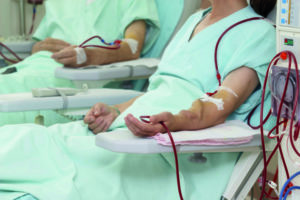 A new study, published online in The Journal of Vascular Access (JVA), suggests that arteriovenous fistulas (AVFs) contribute to higher survival of hemodialysis patients with COVID-19. Authors Ahmet Murt, MD, of Istanbul University-Cerrahpasa, Istanbul, Turkey, and colleagues urge that end-stage renal disease (ESRD) patients “should be given the opportunity to have their vascular access properly created,” even in the pandemic era.
A new study, published online in The Journal of Vascular Access (JVA), suggests that arteriovenous fistulas (AVFs) contribute to higher survival of hemodialysis patients with COVID-19. Authors Ahmet Murt, MD, of Istanbul University-Cerrahpasa, Istanbul, Turkey, and colleagues urge that end-stage renal disease (ESRD) patients “should be given the opportunity to have their vascular access properly created,” even in the pandemic era.
The Kidney Disease Outcomes Quality Initiative (KDOQI) clinical guidelines recommend arteriovenous access instead of central venous catheters for hemodialysis, the authors state. However, the American College of Surgeon’s case triage guideline for COVID-19 deemed AVF or arteriovenous graft (AVG) operations to be elective and suggested that “postponing should be considered.” Against this background, the investigators sought to analyze the effect of vascular access on the outcomes of hemodialysis patients with COVID-19—a group they note are highly clinically vulnerable.
Murt and colleagues retrospectively analyzed 104 hemodialysis patients with COVID-19 from two tertiary care hospitals located in Istanbul. Seventy-two of these patients had AVF as the vascular access, with the remaining 32 patients having had tunneled catheters. They report that COVID-19 had a high mortality rate in hemodialysis patients (36.5%), with AVFs (odds ratio [OR], 3.36; 95% confidence interval [CI], 1.05–10.72; p=0.041) and using medium cut-off dialyzers (OR, 7.99; 95% CI, 1.53–41. 65; p=0.014) being related to higher survival.
In the discussion of their findings, the authors note that those patients with an AVF and those with a catheter were similar for age and comorbidities. “In spite of similarity for COVID-19 severity, peak CRP [C-reactive protein] and ferritin levels were higher for patients in whom catheters were used as vascular access,” they relay, noting that such higher levels in the catheter group point to a higher inflammatory response in catheterized patients.
Murt et al believe that delaying AVF operations “might have socioeconomic, medical, and ethical consequences,” stressing that more frequent use of catheters for hemodialysis will results in more catheter-related complications, requiring longer hospitalizations and, in turn, a higher economic burden.
While the authors recognize that the small sample size may be a limitation of the study, they stress that ESRD patients “should not miss proper vascular access opportunities” based on their findings, especially given that “it does not seem that the pandemic will end in the near future.” They conclude: “Balancing the use of resources with patient-centered decisions should be the approach going forward.”












